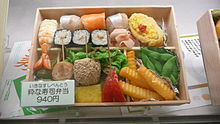Bentō
The Bentō ( Japanese 弁 当 , also O-Bentō お 弁 当 , with the honorary prefix "O") is a widely used form of presentation of food in Japanese cuisine , in which several dishes are separated from each other by partitions in a special box. The box together with the food is also called “Bentō” or “Bentōbox” ( 弁 当 箱 bentō bako ).
history
Bentō has existed in Japan since the 5th century. The first Bentōboxes were bamboo tubes , which are also said to have had an antiseptic effect. Very soon, in order to have food readily available when hunting, working in the fields or fighting against the enemy, simple small wooden boxes were used, some of which were even thrown away after the meal. Bentos have become increasingly popular since the 15th century. Depending on the purpose of the trip, different ways of eating away developed : the wooden boxes, which were now lacquered and often divided into small compartments, were served in the theater as well as at a tea ceremony or a funeral .
Dosage form
In Japan, dishes were and are served in the western style on plates, but more often in the Japanese style in many different bowls from which people eat at the same time. The Bentō offers the possibility of storing and transporting these many small dishes in a single container without them mixing.
The Bentō is originally a take-away meal, analogous to school bread or fish and chips , which are simply wrapped in sandwich or newspaper . Simple food like rice dumplings ( onigiri ) are now also available in Japan in plastic sheets ( plastic wrapped).
Bentō packaging is divided into several compartments inside, in which the food can be arranged. Originally, Bentō were made of light wood. Nowadays, laminated polystyrene or plastic boxes are mostly used as wooden boxes , which are provided with a wooden lid or a transparent plastic lid, which allows a view of the food. But there are also Bentōs in the form of metal boxes or as precious handcrafted lacquered wooden boxes .
Since, in addition to the selection of the ingredients and the preparation, the optical arrangement and the type of packaging are also important, Bentōs can also be total works of art.
- species
- Shōkadō bentō ( 松花 堂 弁 当 ) is a traditional, black lacquered bentō box with four compartments and a lid. It was named after the Shingon monk Shōkadō Shōjō (1582 to 1639).
- Hinomaru bentō ( 日 の 丸 弁 当 ) is a traditional, patriotic way of preparing bentō that was particularly popular during wartime. A red inlaid plum ( umeboshi ) is placed on white rice, which is supposed to symbolize the Japanese flag .
content
The Bentō is just a dosage form, not a specific meal. Practically every dish in Japan today is also offered as a Bentō, right through to Hamburger -Bentō, Spaghetti -Bentō and Schnitzel -Curry Bentō. Spilled meals such as soups are less common. Here, however, there are now absolutely airtight Bentō thermal containers from some Japanese companies for the Bentō prepared at home .
All dishes that are packaged as Bentō can be eaten warm as well as cold. Many Bentō packaging is microwave-permeable so that the Bentō can be heated if necessary. Most shops even have microwave ovens that customers can use to heat the Bentō that has been removed from the cooling compartment.
Traditionally, a Bentō consists of the main ingredients of Japanese cuisine: rice, pieces of fish or meat and various (pickled or cooked) side dishes, such as different types of vegetables , mushrooms and others. Practically all Bentōs (including the "western") have in common that they:
- Have rice as the main dish and
- contain at least five or six different side dishes , sometimes only in small quantities; very often there are a few pieces of pickled vegetables ( tsukemono ) and some potato or noodle salad with them.
- Homemade bentō meal
Typical Bentō with rice and side dishes
Pikachu -Bentō
Bentō store, Tokyo
Availability
In general, Bentō are traditionally freshly prepared at home in the morning. But they can also be bought in many specially set up Bentō stores ( 弁 当 屋 bentō-ya ), for example on train platforms or in shopping centers. Ready- made Bentō are also available in the numerous 24-hour shops (mostly convenience stores , コ ン ニ konbini ).
- Eki-Bentō
Around the so-called Eki-Bentō ( 駅 弁 当 , also 駅 弁 eki-ben ) - Bahnhofs-Bentō - a food culture of its own has developed, since every business at every Japanese express train station ( 新 幹線 駅 Shinkansen -eki ) is only for Bentō offers him typical compilation.
literature
- Naomi Kijima: Bento Boxes. Japanese Meals on the Go. Graph-sha Ltd., Tokyo 2001, ISBN 4-88996-073-2 (English).
- Christopher D. Salyers: Face Food. The Visual Creativity of Japanese Bento Boxes. Mark Batty Publisher, New York NY 2008, ISBN 978-0-9790486-6-1 (English).
Web links
Individual evidence
- ↑ Björn Rosen: Eating & Drinking - Pit Stop. In: Der Tagesspiegel . May 2, 2010, accessed September 29, 2019 .






